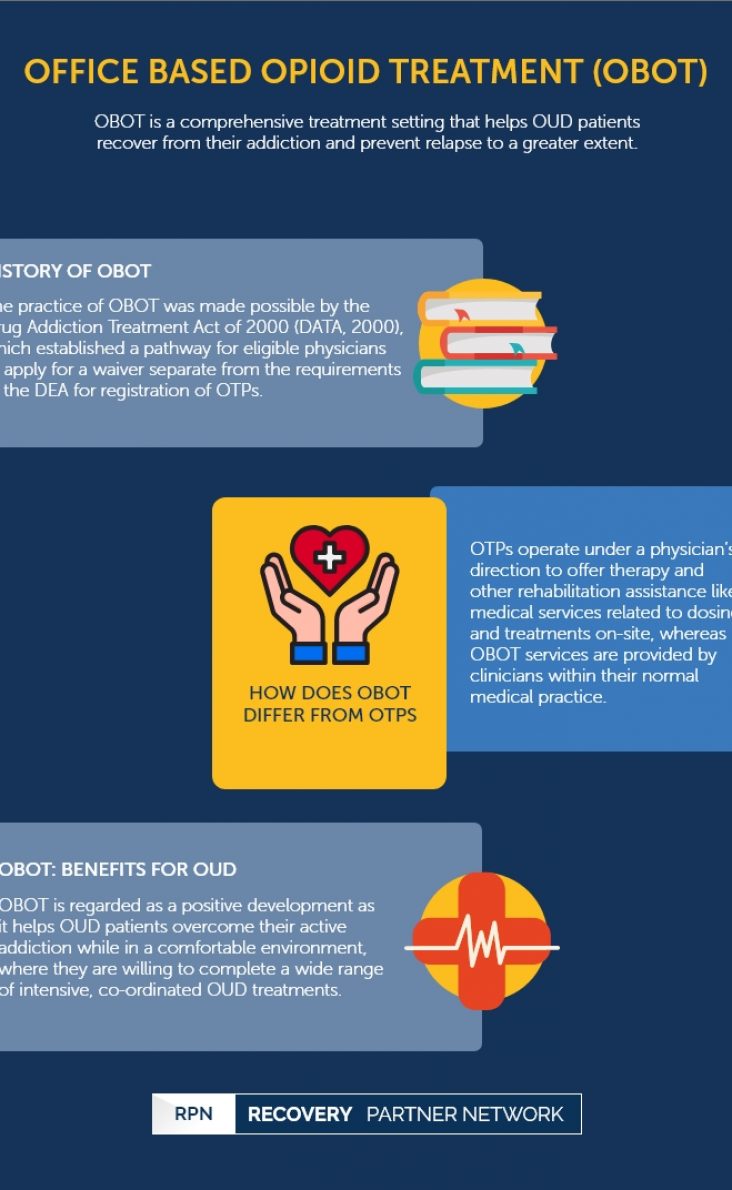OBOT is a comprehensive treatment setting that helps OUD patients recover from their addiction and prevent relapse to a greater extent.
Office Based Opioid Treatment (OBOT)
Office Based Opioid Treatment (OBOT) | Table of Contents
Office-Based Opioid Treatment (OBOT) Services
Office-based opioid treatment (OBOT) refers to outpatient treatment services provided beyond the scope of licensed Opioid Treatment Programs (OTPs). This program prevents opioid usage, overdose deaths, and the spread of infectious diseases. OBOTs is a comprehensive treatment program that is classified under the Medication-Assisted Treatment (MAT) services.
This program involves the use of prescription opioid medications such as naltrexone, buprenorphine, or methadone in conjunction with counseling and behavioral therapy. These medications function by offering relief from withdrawal symptoms while simultaneously reducing cravings for opioids. The most common type of OBOT uses the partial opioid agonist buprenorphine. OBOT allows more physicians the opportunity to treat opioid addiction and the possibility of a more private treatment experience for patients with an opioid use disorder.
OBOT provides various treatment programs and resources, including:
- Medication management
- Case management
- Counseling/therapy
- Relapse prevention
- Overdose education
- Care coordination
The OBOT clinics also frequently partner with other community resources to offer extra assistance to individuals seeking treatment.
FAQ
- What is an office-based opioid treatment program?
- How does the OBOT setting differ from OTPs?
- What are the benefits of OBOT programs?
OBOT refers to outpatient treatment programs provided at settings other than licensed opioid treatment programs. OBOT programs include consultations with a physician, medications, psychological interventions, and support.
OTPs are required to be certified by the Center for Substance Abuse Treatment (CSAT), while OBOT services are provided by physicians within their regular medical practice.
OBOT programs provide patients access to drug treatment without having to enroll in a rehab program. The fewer regulations and requirements placed on patients creates a possibility for easier access to treatments.
History of OBOT
The practice of OBOT was made possible by the Drug Addiction Treatment Act of 2000 (DATA, 2000). The act established a pathway for eligible physicians to apply for a waiver separate from the requirements of the Drug Enforcement Administration (DEA) for registration of OTPs.
DATA 2000 allows physicians to use certain Schedule III-V controlled drugs licensed by the Food and Drug Administration (FDA) to treat OUD patients. In 2002, the FDA approved the usage of buprenorphine, a Schedule III opioid, to manage opioid use disorder. The Comprehensive Addiction and Recovery Act of 2016 expanded on the DATA 2000 to enable nurse practitioners and physician assistants to qualify for the waiver.
How Does OBOT Differ from OTPs?
OBOTs and OTPs (Opioid Treatment Programs) are the only treatment programs in the US that can recommend methadone for opioid use disorders. OTPs are accredited by the Centre for Substance Abuse Treatment (CSAT) of the HHS-SAMHSA division. They work under a physician’s direction to offer therapy and other rehabilitation assistance like medical services related to dosing and treatments on-site, which typically include daily visits to the facility.
However, OBOT services are provided by clinicians within their normal medical practice. This environment will help improve treatment access and offer a more private space for opioid use disorder patients. The OBOT programs have fewer requirements and regulations enforced on the patients, which makes receiving treatment much simpler. For example, OBOT can provide regular on-site dosing as appropriate, but it typically happens in the patient’s home and is not observed by a medical professional.
Services Offered in OBOT
- Comprehensive assessment of substance use disorder.
- Induction of buprenorphine.
- Maintenance with buprenorphine or methadone.
- Group and individual counseling (from once a month to 10 hours a week).
- Case management services.
- Collaboration with community-based medical and psychiatric providers.
- Wrap-around services (e.g., recovery housing, co-management of chronic medical disorders, peer recovery advocates, integrated psychiatric assessment/treatment, and on-site occupational therapy.)
OBOT: Benefits for OUD
The OBOT programs help patients overcome their active addiction while in a comfortable environment, where they are willing to complete a wide range of intensive, co-ordinated OUD treatments.
In addition to the effective usage of controlled medications, the American Society of Addiction Medicine (ASAM) provides a series of guidelines for OBOT services that include the following treatment elements:
- General medical services
- Family support
- Education on addiction
- Individual, group, and family counseling
- Psychiatric care
- Vocational counseling
- Legal counseling
ASAM believes that OBOT is a positive development as it promotes the treatment of addiction in a primary care setting. Although It does not support the exclusive licensing of these sites, it does understand that the use of controlled substances to treat the disease introduces the possibility of misuse, and as such, some states may seek to regulate the practices that deliver such treatment.
Since not all medical centers that provide OBOT services can deliver all of the above-mentioned treatments within a single venue, it is important to develop working partnerships and referral pathways to providers who can offer a full continuum of care to patients with OUD. Besides the service elements, most OBOT services provide community support links like Narcotics Anonymous (NA), Refuge Recovery, or SMART Recovery.
Recovery Partner Network
We aim to educate and empower. If you feel our library of resources does not cover your specific need, reach out to us, and we would be happy to help.
STATISTICS
© Copyright 2025


